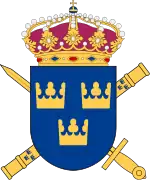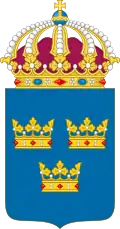Swedish Armed Forces
The Swedish Armed Forces (Swedish: Försvarsmakten, "the Defense Force") is the government agency that forms the military forces of Sweden, and which is tasked with defense of the country, as well as promoting Sweden's wider interests, supporting international peacekeeping efforts, and providing humanitarian aid. It consists of the Swedish Army, the Swedish Air Force and the Swedish Navy, as well as a military reserve force, the Home Guard. Since 1994, all Swedish military branches are organized within a single unified government agency, headed by the Supreme Commander, even though the individual services maintain their distinct identities. King Carl XVI Gustaf is traditionally considered Honorary General and Admiral à la suite.[8]
| Swedish Armed Forces | |
|---|---|
| Försvarsmakten | |
 Coat of arms of the Swedish Armed Forces. | |
War flag and Naval Ensign of Sweden | |
| Founded | 1521 |
| Current form | 1975 |
| Service branches | |
| Headquarters | Stockholm |
| Website | www |
| Leadership | |
| Executive Authority | Government (Löfven II Cabinet) |
| Minister of Defence | Peter Hultqvist |
| Supreme Commander | General Micael Bydén |
| Director-General | Peter Sandwall |
| Chief of Defence Staff | Vice Admiral Jonas Haggren |
| Manpower | |
| Military age | 16–70 years old[1] |
| Conscription | Yes[2][3][4] |
| Available for military service | 3,020,782 males, age 18–47 (2017 est.), 2,760,451 females, age 18–47 (2017 est.) |
| Fit for military service | 1,980,592 males, age 18–47 (2017 est.), 1,649,875 females, age 18–47 (2017 est.) |
| Reaching military age annually | 58,937 males (2017 est.), 56,225 females (2017 est.) |
| Active personnel | 22,500[5] |
| Reserve personnel | 34,500 Reservists |
| Expenditures | |
| Budget | SEK 60.6 billion (~$7.2 billion) (2019)[6] |
| Percent of GDP | 1.1% (2019)[7] |
| Industry | |
| Domestic suppliers | BAE Systems AB Saab Bofors Dynamics Saab AB |
| Related articles | |
| History | Military history of Sweden |
| Ranks | Military ranks of the Swedish Armed Forces |
The Swedish Armed Forces consist of a mix of volunteers and conscripts. About 4,000 men and women are called up for service every year;[9] this is expected to increase to 8,000 per year by 2025.[10]
Units from the Swedish Armed Forces are currently on deployment in several international operations either actively or as military observers, including Afghanistan as part of the Resolute Support Mission and in Kosovo (as part of Kosovo Force).[11] Moreover, Swedish Armed Forces contribute as the lead nation for an EU Battlegroup approximately once every three years through the Nordic Battlegroup. Sweden has close relations with NATO and NATO members, and participates in training exercises like the Admiral Pitka Recon Challenge, and Exercise Trident Juncture 2018. Sweden also has a strong cooperation with its closest allies of the Nordic countries being part of the Nordic Defence Cooperation (NORDEFCO) and joint exercises such as Exercise Northern Wind 2019.[12] In total, about 10,000 people participate in Northern Wind, of which approximately 7,000 come from prioritized cooperation states: Finland, Norway, the US and the UK.
Sweden has not participated in an officially declared war since the 1814 Swedish–Norwegian War, although e.g. Swedish aircraft took part in the NATO-led 2011 military intervention in Libya. Swedish foreign policy has managed to keep Sweden out of war through a policy of neutrality.
Sweden also provides information to its citizens in case of an emergency being part of the concept of total defense with pamphlets being sent home to all households. The publication contains information about how to act in a situation of national crisis and most notably, nuclear war. The pamphlets (titled "If the war comes") were distributed to all households from 1943 to 1961; after 1961 some of the information from the pamphlet was printed in every phone book until 1991, the end of the Cold War. In 2018 the pamphlet was renewed and distributed under the title "If the crisis or the war comes" (Swedish: Om krisen eller kriget kommer). The new pamphlet includes the well-known quote from the older ones (in case of enemy invasion): "Every statement that the resistance has ceased is false. Resistance shall be made all the time and in every situation. It depends on You - Your efforts, Your determination, Your will to survive."[13]
History
After a period of enhanced readiness during World War I, the Swedish Armed Forces were subject to severe downsizing during the interwar years. When World War II started, a large rearmament program was launched to once again guard Swedish neutrality, relying on mass conscription to fill the ranks.
After World War II, Sweden considered building nuclear weapons to deter a Soviet invasion. From 1945 to 1972 the Swedish government ran a clandestine nuclear weapons program under the guise of civilian defense research at the Swedish National Defence Research Institute. By the late 1950s the work had reached the point where underground testing was feasible. However, at this time the Riksdag prohibited research and development of nuclear weapons, pledging that research should be done only for the purpose of defense against nuclear attack. They reserved the right to continue development of nuclear weapons in the future. The option to continue development of weapons was abandoned in 1966, and Sweden's subsequent signing of the Non-Proliferation Treaty in 1968 began the wind-down of the program, which finally concluded in 1972.
During the Cold War, the wartime mass conscription system was kept in place to act as a deterrent to the Soviet Union, seen as the greatest military threat to Sweden. The end of the Cold War and the collapse of the Soviet Union meant that the perceived threat lessened and the armed forces were downsized, with conscription taking in less and less recruits until it was deactivated in 2010 (and then reactivated in 2017).
After twenty years of cooperation with NATO, starting with the Partnership for Peace back in 1994, Sweden was one of five partners granted enhanced opportunities for dialogue and cooperation at the Wales Summit in 2014. The status of Enhanced Opportunities Partner provided a platform for developing a more flexible and individualized relationship, in addition to other partner formats. It coincided with Russia's illegal annexation of Crimea and military intervention in Eastern Ukraine, and also with NATO defense bill for 2016-2020. Both the need to review NATO's own defense policy and the dramatic signal that a European country was prepared to violate the existing security order using military might, gave momentum to the new partner platform. Conscription was reintroduced in 2017 to supplement the insufficient number of volunteers signing up for service.
Doctrine
The Swedish Armed Forces have four main tasks:[14]
- To assert the territorial integrity of Sweden.
- To defend the country if attacked by a foreign nation.
- To support the civil community in case of disasters (e.g. flooding).
- To deploy forces to international peace support operations.
Sweden aims to have the option of remaining neutral in case of proximate war.[15] However, Sweden cooperates militarily with a number of foreign countries. As a member of the European Union, Sweden is acting as the lead nation for EU Battlegroups[16] and also has a close cooperation, including joint exercises, with NATO through its membership in Partnership for Peace and Euro-Atlantic Partnership Council.[17] In 2008 a partnership was initiated between the Nordic countries to, among other things, increase the capability of joint action, and this led to the creation of the Nordic Defence Cooperation (NORDEFCO).[18][19] As a response to the expanded military cooperation the defence proposition of 2009 stated that Sweden will not remain passive if a Nordic country or a member of the European Union were attacked.[20]
Recent political decisions have strongly emphasized the capability to participate in international operations, to the point where this has become the main short-term goal of training and equipment acquisition.[21][22][23] However, after the 2008 South Ossetia war territorial defense was once again emphasized. Until then most units could not be mobilized within one year. In 2009 the Minister for Defence stated that in the future all of the armed forces must capable of fully mobilizing within one week.[24]
In 2013, after Russian air exercises in close proximity to the Swedish border were widely reported, only six percent of Swedes expressed confidence in the ability of the nation to defend itself.[25]
Organization
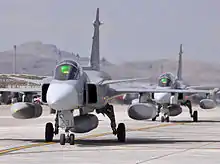
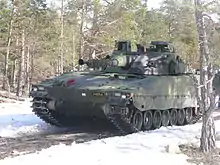
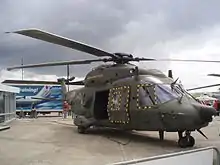
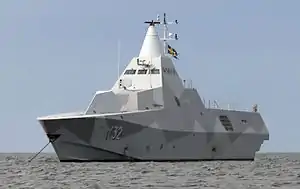
The Supreme Commander (Swedish: Överbefälhavaren) is a four-star general or flag officer that is the agency head of the Swedish Armed Forces, and is the highest ranking professional officer on active duty. The Supreme Commander in turn reports, normally through the Minister of Defence, directly to the Government of Sweden, which in turn answers to the Riksdag.
The King of Sweden was, before the enactment of the 1974 Instrument of Government, the de jure commander in chief (Swedish: högste befälhavare), but currently only has a strictly ceremonial and representative role with respect to the Armed Forces.[8]
The Swedish Armed Forces consists of three service branches; the Army, the Air Force and the Navy, with addition of the military reserve force Home Guard. Since 1994, the first three service branches are organized within a single unified government agency, headed by the Supreme Commander, while the Home Guard reports directly to the Supreme Commander. However, the services maintain their separate identities through the use of different uniforms, ranks, and other service specific traditions.
Armed Forces Headquarters
The Swedish Armed Forces Headquarters is the highest level of command in the Swedish Armed Forces.[26] It is led by the Supreme Commander with a civilian Director General as his deputy, with functional directorates having different responsibilities (e.g. the Military Intelligence and Security Service). Overall, the Armed Forces Headquarters have about 1,000 employees, including civilian personnel.[27][28]
Schools
Some of the schools listed below answer to other units, listed under the various branches of the Armed Forces:
- Artillery Combat School (ArtSS) located in Boden
- Armed Forces Technical School (FMTS) located in Halmstad
- Air Warfare Centre (LSS) located in Uppsala
- Armed Forces Interpreter/Interrogator School (TolkS) located in Uppsala
- Swedish Defence University (FHS) located in Stockholm
- Field Work School (FarbS) located in Eksjö
- Air Force Air Officer School (FBS) located in Uppsala
- Swedish Parachute Ranger School (FJS) located in Karlsborg
- Flight School (FlygS) located in Linköping/Malmen
- Helicopter Combat School (HkpSS) located in Linköping/Malmen
- Home Guard Combat School (HvSS) located in Södertälje
- Command School (LedS) located in Enköping
- Anti-Aircraft Combat School (LvSS) located in Halmstad
- Military Academy Halmstad (MHS H) located in Halmstad
- Military Academy Karlberg (MHS K) located in Stockholm/Karlberg
- Land Warfare Centre (MSS) located in Skövde also a detachment in Kvarn[29]
- Swedish Naval Warfare Centre (SSS) located in Karlskrona and Stockholm/Berga[30]
Centres
- Swedish Armed Forces Centre for Defence Medicine (FömedC) located in Gothenburg, with a section in Linköping
- Armed Forces Logistics (FMLOG) located in Stockholm, Boden, Karlskrona and Arboga
- Armed Forces Intelligence and Security Centre (FMUndSäkC) located in Uppsala
- Armed Forces Musical Centre (FöMusC) located in Stockholm/Kungsängen
- Recruitment Centre (RekryC) located in Stockholm
- National CBRN Defence Centre (SkyddC) located in Umeå
- Swedish EOD and Demining Centre (SWEDEC) located in Eksjö
- Swedish Armed Forces International Center (Swedint) located in Stockholm/Kungsängen
Nordic Battlegroup
The Nordic Battlegroup is a cooperative formation of the Swedish Armed Forces alongside mainly the other Nordic countries but also some of the Baltic countries as well as Ireland, tasked as one of the EU Battlegroups. The headquarter garrison for this group is currently situated in Enköping, Sweden.
International deployments
Currently, Sweden has military forces deployed in Afghanistan with the NATO-led Resolute Support Mission. Swedish forces were part of the previous International Security Assistance Force (2002–2014) in Afghanistan. Sweden is also part of the multinational Kosovo Force and has a naval force deployed to the gulf of Aden as a part of Operation Atalanta. Military observers from Sweden have been sent to a large number of countries, including Georgia, Lebanon, Israel and Sri Lanka and Sweden also participates with staff officers to missions in Sudan and Chad. Sweden has been one of the Peacekeeping nations of the Neutral Nations Supervisory Commission that is tasked with overseeing the truce in the Korean Demilitarized Zone since the Korean war ended in 1953.[31]
Past deployments
A battalion and other units were deployed with the NATO-led peacekeeping SFOR in Bosnia and Herzegovina (1996–2000), following the Bosnian War.
Swedish air and ground forces saw combat during the Congo Crisis, as part of the United Nations Operation in the Congo force. 9 army battalions were sent in all, and their mission lasted 1960–1964.
Personnel
From national service to an all-volunteer force

In mid-1995, with the national service system based on universal military training, the Swedish Army consisted of 15 maneuver brigades and, in addition, 100 battalions of various sorts (artillery, engineers, rangers, air defense, amphibious, security, surveillance etc.) with a mobilization-time of between one and two days. When national service was replaced by a selective service system, fewer and fewer young men were drafted due to the reduction in size of the armed forces. By 2010 the Swedish Army had two battalions that could be mobilized within 90 days. When the volunteer system has been fully implemented by 2019, the army will consist of 7 maneuver battalions and 14 battalions of various sorts with a readiness of one week. The Home Guard will be reduced in size to 22,000 soldiers.[32] In 2019 the Swedish Armed Forces, now with a restored national service system combined with volunteer forces, aimed to reach 3 brigades as maneuver units by 2025.[33]
| National Service Force 1995 | Selective Service Force 2010 | All-Volunteer Force 2019 | Selective Service Force/Volunteer Force 2025 | |
|---|---|---|---|---|
| Maneuver units | 15 brigades | 2 battalions | 7 battalions | 3 brigades |
| Auxiliary units | 100 battalions | 4 companies | 14 battalions | ? |
| Readiness | 1 to 2 days | 90 days | 7 days | ? |
Re-implementing conscription
After having ended the universal male conscription system in 2010, as well as deactivating conscription in peacetime, the conscription system was re-activated in 2017. Since 2018 both women and men are conscripted on equal terms.[9] The motivation behind reactivating conscription was the need for personnel, as volunteer numbers proved to be insufficient to maintain the armed forces.[9][34]
Personnel structure
Military personnel of the Swedish Armed Forces consists of:
- Officer OFF/K – Regular continuously serving officers (OF1-OF9).
- Officer OFF/T – Reserve part-time officers (OF1-OF3).
- Specialistofficer SO/K – Regular continuously serving NCO (OR6-OR9).
- Specialistofficer SO/T – Reserve part-time serving NCO (OR6-OR7).
- GSS/K – Regular continuously serving enlisted (OR1-OR5).
- GSS/T – Reserve part-time serving enlisted (OR1-OR5).
- GSS/P – Personnel in wartime placement (OR1-OR5).
K = Continuously
T = Part-time
P = Conscript, for personnel drafted under the Swedish law of comprehensive defense duty
Planned size of the Swedish Armed Forces 2011–2020
| Category | Continuously serving | Part-time serving | Contracted |
|---|---|---|---|
| OFF | 3,900 OFF/K | 2,600 OFF/T | – |
| SO | 4,900 SO/K | included in the above SO/T | – |
| GSS | 6,600 GSS/K | 9,500 GSS/T | - |
| Home Guard | – | – | 22,000 |
Annual recruitment of GSS is assumed to be about 4,000 persons.
Source:[35]
Criticism and research
In 2008, professor Mats Alvesson of the University of Lund and Karl Ydén of the University of Göteborg claimed in an op-ed, based on Ydén's doctoral dissertation, that a large part of the officer corps of the Swedish Armed Forces was preoccupied with administrative tasks instead of training soldiers or partaking in international operations. They claimed that Swedish officers were mainly focused on climbing the ranks and thereby increasing their wages and that the main way of doing this is to take more training courses, which decreases the number of officers that are specialized in their field. Therefore, the authors claimed, the Swedish Armed Forces was poorly prepared for its mission.[36]
Major changes have been made to the officer system since then.
The transformation of the old invasion defence-oriented armed forces to the new smaller and more mobile force has also been criticized. According to the Supreme Commander of the Swedish Armed Forces the present defence budget will not be enough to implement the new defence structure by 2019. And that even when finished the armed forces will only be able to fight for a week at most.[37]
During 2013 several Russian Air Force exercises over the Baltic Sea aimed at Swedish military targets have made the future of the Swedish Armed Forces a hot topic and several political parties now want to increase defense funding.[38][39][40] In August 2019, the government announced a bank tax to fund the military spending.[41]
Ranks
When an army based on national service (conscription) was introduced in 1901 all commissioned officers had ranks that were senior of the warrant officers (underofficerare) and non-commissioned officers (underbefäl). In a reform 1926 the relative rank of the then senior warrant officer, fanjunkare, was increased to be equal with the junior officer rank underlöjtnant and above the most junior officer rank fänrik. In 1960 the relative rank of the warrant officers were elevated further so that
- i. The lowest warrant officer, sergeant, had relative rank just below the lowest officer rank, fänrik.
- ii. The second warrant officer rank, fanjunkare, had relative rank between fänrik and löjtnant
- iii. The highest warrant officer rank, förvaltare, had relative rank between first lieutenant and captain.
In 1972 the personnel structure changed, reflecting increased responsibilities of warrant and non-commissioned officers, renaming the underofficerare as kompaniofficerare, giving them the same ranks as company grade officers (fänrik, löjtnant, kapten). Underbefäl was renamed plutonsofficerare and given the rank titles of sergeant and fanjunkare, although their relative rank were now placed below fänrik. The commissioned officers were renamed regementsofficerare, beginning with löjtnant. The three-track career system was maintained, as well as three separate messes.
A major change in the personnel structure in 1983 (NBO 1983), merged the three professional corps of platoon officers, company officers, and regimental officers into a one-track career system within a single corps called professional officers (yrkesofficerare). The three messes were also merged to one.
In 2008 the Riksdag decided to create a two-track career system with a category called specialistofficerare. When implementing the parliamentary resolution the Supreme Commander decided that some ranks in this category should, like the old underofficerare ranks in 1960–1972, have a relative rank higher than the most junior officers.
Other government agencies reporting to the Ministry of Defence
- Swedish Defence Materiel Administration, or Försvarets materielverk (FMV)
- Swedish National Service Administration, or Pliktverket
- Swedish Defence University, or Försvarshögskolan
- Swedish National Defence Radio Establishment, or Försvarets radioanstalt (FRA)
- Swedish Defence Research Agency, or Totalförsvarets forskningsinstitut (FOI)
- Swedish Civil Contingencies Agency, or Myndigheten för samhällsskydd och beredskap
Voluntary defence organizations
- Home Guard
- Swedish Women's Voluntary Defence Organization ("Lottorna")
See also
- Society and Defence
- Scandinavian defence union
- Gotland National Conscription
- Origins of Swedish conscription system
- Per Albin Line
- Military on Gotland
- Swedish Fortifications Agency
- Swedish National Inspectorate of Strategic Products
- List of wars involving Sweden
- List of Swedish military commanders
- List of Swedish monarchs
- List of Swedish regiments
- List of military aircraft of Sweden
- List of Swedish military calibers
References
- SFS 2010:448. Lag (1994:1809) om totalförsvarsplikt. Stockholm: Department of Justice. "Lag (1994:1809) om totalförsvarsplikt". www.lagen.nu (in Swedish). Archived from the original on 2010-12-17. Retrieved 2010-11-13.
- "Värnplikten återinförs – tusentals kallas till mönstring". Svenska Dagbladet (in Swedish). TT. 2017-03-02. Archived from the original on 2017-03-02. Retrieved 2017-03-02.
- Nilsson, Christoffer (2 March 2017). "Regeringen inför värnplikt i Sverige – beslut i dag". Aftonbladet (in Swedish). Archived from the original on 2017-03-02. Retrieved 2017-03-02.
- "En kombination av frivillighet och plikt" (in Swedish). Swedish Armed Forces. 2 March 2017. Archived from the original on 2017-03-02. Retrieved 2017-03-02.
- "Personalsiffror". Swedish Armed Forces. Archived from the original on 2015-03-25. Retrieved 2015-04-04.
- "Statens budget i siffror" (in Swedish). Government Office of Sweden. 15 November 2018. Retrieved 13 April 2019.
- "Military expenditure by country as percentage of gross domestic product, 1988-2019" (PDF). Stockholm International Peace Research Institute. 2020. p. 13. Retrieved 7 August 2020.
- "Duties of the Monarch". Royal Court of Sweden. Archived from the original on 2015-03-16. Retrieved 2015-03-19.
- Persson, Alma; Sundevall, Fia (2019-12-17). "Conscripting women: gender, soldiering, and military service in Sweden 1965–2018". Women's History Review. 28 (7): 1039–1056. doi:10.1080/09612025.2019.1596542. ISSN 0961-2025.
- Regeringskansliet, Regeringen och (2020-10-16). "Substantial investment in total defence". Regeringskansliet. Retrieved 2020-12-12.
- "Försvarsmakten utomlands - Försvarsmakten".
- https://www.forsvarsmakten.se/siteassets/2-var-verksamhet/ovningar1/nw19/folder-nw19-webb.pdf
- Oksanen, Patrik (2018-05-27). "Ledare: Vet du vad du gör om krisen eller kriget kommer?". Falu Kuriren (in Swedish). Retrieved 2018-05-27.
- "Försvarets fyra huvuduppgifter" (in Swedish). Swedish Armed Forces. 2013-09-17. Archived from the original on 17 September 2013.
- "Sveriges säkerhetspolitik" (in Swedish). Government Offices of Sweden. 25 March 2008. Archived from the original on 2008-10-19.
Sverige är militärt alliansfritt. Denna säkerhetspolitiska linje, med möjlighet till neutralitet vid konflikter i vårt närområde, har tjänat oss väl.
- "Nordic Battlegroup". Swedish Armed Forces. 2009-01-19. Archived from the original on June 3, 2009. Retrieved 2009-08-05.
- Sverige och NATO Archived 2011-06-13 at the Wayback Machine (In Swedish)
- "Nordic defence cooperation". Swedish Armed Forces. 2009-03-06. Archived from the original on 2009-09-03. Retrieved 2009-08-05.
- "Background to cooperation". Swedish Armed Forces. 2009-03-06. Archived from the original on 2012-08-05. Retrieved 2009-08-05.
- Ett användbart försvar Archived 2015-02-25 at the Wayback Machine, last paragraph (In Swedish)
- Försvarsreformen Archived 2008-06-01 at the Wayback Machine (In Swedish)
- "Our task". Swedish Armed Forces. 2007-09-25. Archived from the original on 2009-08-03. Retrieved 2009-08-05.
- "The Swedish military service system". Swedish Armed Forces. 2007-09-28. Archived from the original on 2009-09-01. Retrieved 2009-08-05.
- "Ett användbart försvar – med kraftigt stärkt försvarsförmåga". regeringen.se. Archived from the original on 25 February 2015. Retrieved 25 February 2015.
- Benitez, Jorge (30 April 2013). "Most Swedes doubt Sweden can defend itself". acus.org. Atlantic Council. Archived from the original on 3 July 2013. Retrieved 30 April 2013.
- "Armed Forces Headquarters (HKV)". Swedish Armed Forces. 2008-12-01. Archived from the original on 2020-07-28. Retrieved 2009-08-05.
- "?" (in Swedish). Swedish Armed Forces. Archived from the original on 2020-07-28. Retrieved 2009-05-03.
- "?" (PDF) (in Swedish). Swedish Armed Forces.
- "Archived copy". Archived from the original on 2008-04-10. Retrieved 2008-05-28.CS1 maint: archived copy as title (link)
- "Training Centres". Swedish Armed Forces. Archived from the original on 20 March 2015. Retrieved 25 February 2015.
- "Korea – NNSC". Swedish Armed Forces. Archived from the original on 6 April 2016. Retrieved 25 February 2015.
- Ivarsson, Ulf (February 2007). "Pendeln måste slå tillbaka". Hemvärnet (1): 5.
- "Försvarsberedningen föreslår fyra nya regementen och utökad verksamhet på flera platser". Dagens Nyheter (in Swedish). 2019-05-14. Retrieved 2019-05-14.
- Reuters: Sweden returns draft amid security worries and soldier shortage Archived 2018-03-07 at the Wayback Machine, 2 March 2017
- Ulf Jonsson & Peter Nordlund, Frivilliga soldater istället för plikt 8FOI 2010 12/11/2012
- "Karriärstyrda officerare skapar inkompetent försvar". Dagens Nyheter (in Swedish). 2008-11-06. Archived from the original on 2012-11-14. Retrieved 2013-03-28.
- "Försvar med tidsgräns". Svenska Dagbladet (in Swedish). Archived from the original on 23 March 2015. Retrieved 25 February 2015.
- "Ryska bombflyg övade mot Sverige". Svenska Dagbladet (in Swedish). Stockholm. TT. Archived from the original on 15 April 2015. Retrieved 25 February 2015.
- "Ryskt flyg övade anfall mot Sverige". Svenska Dagbladet (in Swedish). Archived from the original on 23 March 2015. Retrieved 25 February 2015.
- "Majoritet vill rusta militärt mot Ryssland". Aftonbladet (in Swedish). Archived from the original on 25 February 2015. Retrieved 25 February 2015.
- "Sweden announces bank tax to finance military spending". France 24. 2019-09-01. Retrieved 2019-09-01.
Manpower-numbers are taken from CIA – The World Factbook
External links
- Official website (in English)


